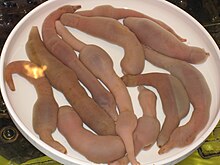Urechis unicinctus
| Urechis unicinctus | |
|---|---|

| |
| Urechis unicinctus at a market in Korea. | |
| Scientific classification | |
| Domain: | Eukaryota |
| Kingdom: | Animalia |
| Phylum: | Annelida |
| Clade: | Pleistoannelida |
| Clade: | Sedentaria |
| Subclass: | Echiura |
| Order: | Echiuroidea |
| Family: | Urechidae |
| Genus: | Urechis
|
| Species: | U. unicinctus
|
| Binomial name | |
| Urechis unicinctus | |
Urechis unicinctus, known as the fat innkeeper worm or penis fish,
Ecology
This spoonworm is a detritivore, feeding on detritus and lives and burrows in sand and mud like other Urechis species. It creates a U-shaped burrow in the soft sediment of the seabed. A ring of glands at the front of the proboscis secrete mucus which sticks to the burrow wall. The worm continues to exude mucus as it moves backwards in the burrow thus creating a mucus net. The worm draws water through its burrow by peristaltic contractions of its body and food particles adhere to the net. When enough food is gathered, the worm moves forward in its burrow and swallows the net and entangled food. This process is repeated, and in an area with plenty of detritus, may be completed in only a few minutes.[6][7]
Large numbers have been known to become stranded on beaches in Japan, but further studies must be dedicated as to why. The original theory was that it was beached solely due to sea storms, but scientists also theorize that they swim at night to reproduce, which would raise the chances of beachings.[8]
Uses
In Korea, it is called Gaebul (Korean: 개불), which means a dog's testicle or penis. They are eaten as food,[9] often raw with salt and sesame oil or gochujang. They are distributed in Korea, Hokkaido, and the Pacific coast.
In
It is also used as
- Urechis unicinctus
-
Urechis unicinctus (개불; gaebul) sold at a fish market at Busan, South Korea.
-
Urechis unicinctus served ashoein a restaurant in South Korea.
References
- ^ van der Land, Jacob; Murina, Galina Vansetti (2012). "Urechis unicinctus (Drasche, 1880)". WoRMS. World Register of Marine Species. Retrieved 2012-11-12.
- ^ "Zur Kenntnis des Baues der Segmentalorgane bei Echiuren". Zoologischer Anzeiger (in German). 3 (46–72). Jena: VEB Gustav Fischer Verlag: 517–519. 1880 – via Biodiversity Heritage Library.
- ^ "UFE - Fibrinolytic enzyme - Urechis unicinctus (Fat innkeeper worm) - UFE gene & protein". www.uniprot.org. Retrieved 2019-12-16.
- ^ S2CID 3560690.
- ^ Cowles, Dave (2010). "Urechis caupo Fisher and MacGinitie, 1928". Invertebrates of the Salish Sea. Rosario Beach Marine Laboratory (a campus of Walla Walla University, Washington). Retrieved 25 January 2019.
- ISBN 0-86622-141-7.
- ^ "Fat innkeeper worm". Monterey Bay Aquarium. Retrieved 2024-01-17.
- PMID 24698400.
External links
- 5 Korean foods for adventurous eaters Chincha.co.uk


